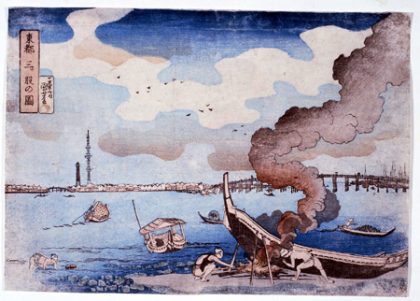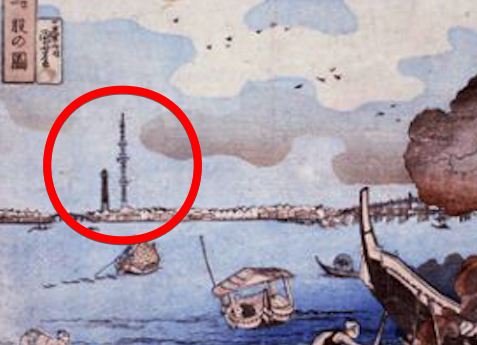Urban Legends from Japan – Strange Tales, Mysterious Encounters, and Modern Myths
A Time-Traveling Artist? The Mystery of the Tokyo Skytree in an 1831 Japanese Woodblock Print

In the world of art history, few mysteries are as captivating as an anachronism—an object that appears impossibly out of its time. But what if that object wasn’t just a minor detail, but one of the world’s most famous modern landmarks, appearing in a piece of art nearly 200 years before it was built? This is the incredible urban legend surrounding Utagawa Kuniyoshi, a master of the ukiyo-e style, who seemingly depicted the Tokyo Skytree in a print from 1831.
The Artist and the Anomaly
Utagawa Kuniyoshi (1798-1861) was one of the last great masters of the Japanese ukiyo-e art form, a genre of woodblock prints and paintings. Unlike his contemporaries who focused on serene landscapes, Kuniyoshi was a brilliantly eccentric and pop-culture-savvy creator. He was famous for his dynamic warrior prints, beautiful courtesans, clever optical illusions, and fantastical depictions of yokai (monsters and spirits). His imaginative and often bizarre style made him a legend.
The mystery lies within one of his works, a landscape print from 1831 titled Tōto Mitsumata no zu (“View of the Three-Forked Riverbank in the Eastern Capital”). The piece depicts a bustling scene of boat builders and cargo ships in Edo (modern-day Tokyo). In the background, familiar bridges like the Eitai and Mannen are visible. But next to the Mannen Bridge stands something utterly impossible: a tall, slender, tower-like structure that bears an uncanny resemblance to the Tokyo Skytree.
The Skytree, a 634-meter (2,080 ft) broadcasting and observation tower, is the tallest tower in the world and an icon of modern Tokyo. It was completed in 2012. How could it possibly appear in a print made 181 years earlier?
A Rational Explanation: The Well-Digging Derrick
The mystery first gained widespread attention in 2011 when the Tokyo Shimbun newspaper published an article about the strange tower. This sparked a wave of speculation. Was Kuniyoshi a prophet who foresaw the future of his city? Or, more fantastically, was he a time traveler who had seen modern Tokyo with his own eyes?
As compelling as these theories are, a more mundane explanation has since become widely accepted. The tower is believed to be a ido-hori-yagura—a tall, temporary wooden derrick used for digging deep water wells.
The area depicted in the print, Fukagawa, was built on reclaimed land. Shallow wells in this area would have produced salty, undrinkable water. To reach a source of fresh water, it was necessary to dig much deeper than usual, requiring a significantly taller derrick than the standard fire watchtowers of the era (one of which is visible to the left of the mystery tower). Because these derricks were temporary structures, they would have been dismantled after the well was completed, explaining why the tower doesn’t appear in later paintings of the same location.

The Enduring Legend
While the well-digging derrick theory is logical, it doesn’t answer every question. Was such an unusually tall structure truly necessary? And if so, why does no other historical record of it seem to exist? This lack of definitive proof keeps the door open for more fantastical theories.
Kuniyoshi’s reputation as an imaginative genius has only fueled the urban legends. Another of his prints, Edo Jiman Meibutsu Kurabe (“A Comparison of Famous Products of Edo”), was once rumored to show a woman holding an iPhone. In reality, the piece is subtitled “Komagome Eggplant,” and she is simply peeling an eggplant.
Whether he was a prophet, a time traveler, or simply an artist with an extraordinary eye for the unusual, Utagawa Kuniyoshi created a world so vivid and strange that it continues to inspire mystery. The “Skytree” in his print remains a powerful symbol of his unique vision—a vision so powerful, it seems to transcend time itself.
※ Unauthorized reproduction, video creation, and uploading of this article's content to YouTube, blogs, or other platforms is strictly prohibited.
Related Articles
Popular Series
This is the page for A Time-Traveling Artist? The Mystery of the Tokyo Skytree in an 1831 Japanese Woodblock Print. Find the latest news about JapaneseHistory, TimeTravel, Ukiyo-e and more on TOCANA - the paranormal news media that stimulates your curiosity
Urban Legends Latest Articles
The Definitive Guide to Japan's Scariest Urban Legends: From Kuchisake-Onna to Kisaragi Station
2025.10.20 23:00 Urban LegendsKunekune: The Definitive Guide to Japan's Terrifying, Twisting Field Monster
2025.10.19 23:00 Urban LegendsNNN Special Broadcast: The Definitive Guide to Japan's Lost, Lethal TV Broadcast
2025.10.14 23:00 Urban Legends


